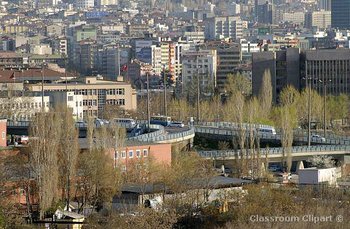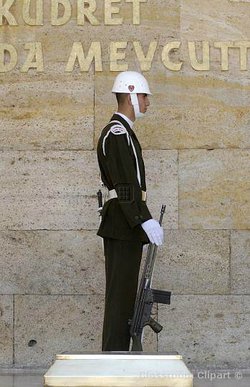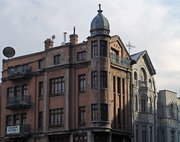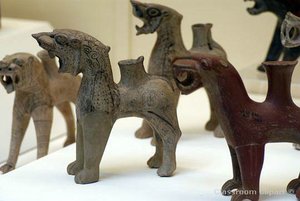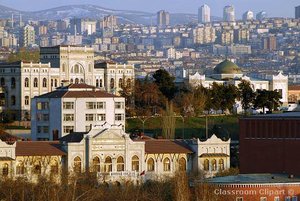Ankara
|
|
Ankara is the capital of Turkey and the country's second largest city after Istanbul. The city has a population of 5,153,000 (2005), and a mean elevation of 850 m. (2800 ft.) It was formerly known as Angora or Engürü, and in the classical period, as Ancyra.
Centrally located in Anatolia, Ankara is an important commercial and industrial city, has been the neural center of Turkish Government, and houses all the foreign embassies. It is an important crossroads of trade, strategically located at the center of Turkey's highway and rail network, and serves as the marketing center for the surrounding agricultural area. The city was famous for its long-haired goat and its wool (Angora wool), a unique breed of cat (Ankara Cat), white rabbits, pear, honey, and the region's muscat grapes.
Ankara is situated upon a steep and rocky hill, which rises 500 ft. above the plain on the left bank of the Enguri Su, a tributary of the Sakarya (Sangarius) River. The city is located 39°52'30" North, 32°50' East (39.875, 32.8333).
[1] (http://earth-info.nga.mil/gns/html/cntry_files.html) The hill is crowned by the ruins of the old castle, which add to the picturesqueness of the view; but the town was not well built, many of its houses constructed of sun-dried mud bricks and the streets are narrow. There are, however, many fine remains of Greek, Roman and Byzantine architecture, the most remarkable being the temple of Augustus, on the walls of which is the famous Monumentum Ancyranum[2] (http://penelope.uchicago.edu/Thayer/E/Roman/Texts/Augustus/Res_Gestae/home.html)
| Contents |
History
The region's vibrant history goes back to the Bronze Age Hatti civilization, which was succeeded in the 2nd millennium BC by the Hittites, in the 10th century BC by the Phrygians, then by the Lydians and Persians.
The Persian sovereignty continued until the defeat of the Persians during the Asia campaign of the Macedonian king, Alexander the Great. In 333 BC, Alexander came from Gordium to Ankara and stayed in the city for a period of time. After his death at Babylon in 323 BC, Ankara and its environs fell into the share of Antigonus.
In 278 BC, Ankara was occupied by the Gaulish race Galatians who were the first to make Ankara their capital. It was then known as Ancyra, meaning "anchor", one of the oldest words in the language of the seafarer Gauls. Ankara's organized and written history starts with the Galatians.
The city subsequently fell to the Romans in 189 BC. During the Roman rule, Ankara became a gate to the east for Rome, and as such, was well developed, achieving the status of "city-state", or polis. The military as well as logistical importance of the city continued well within the long Byzantine reign, even after their capital was moved to Constantinople. Although Ankara fell into the hands of several Arab armies numerous times after the 6th century, it remained an important crossroads polis within the Byzantine Empire until late 11th century.
In 1071 Seljuk Sultan Alparslan opened the door to Anatolia for the Turks at the victory of Malazgirt. He then annexed Ankara, an important location for military transportation and natural resources, to Turkish territory in 1073.
Orhan I, second bey of the Ottoman Empire captured the city in 1356. Turkic leader Timur Lenk besieged Ankara as part of his campaign in Anatolia, but in 1403 Ankara was again in the control of the Ottomans.
At the close of World War I, Turkey was under the control of the Ottoman sultan and having lost the war, was being shared by the Greeks, the French, the British, and the Italians. The leader of the Turkish nationalists, [[Kemal Atat?established the headquarters of his resistance movement in Ankara in 1919 (See Treaty_of_Sèvres and Turkish War of Independence). After the War of Independence as won and the Ottoman Empire was banished, Turkey was declared a republic in October 29, 1923, Ankara having had replaced Istanbul (formerly Constantinople) as the capital of the new republic on October 13, 1923.
After Ankara became the capital of Turkey, new development has divided the city into an old section, called Ulus, and new section, called Yenişehir. Ancient buildings reflecting Roman, Byzantine, and Ottoman history and narrow winding streets mark the old section. The new section has the trappings of a more modern city: wide streets, hotels, theaters, shopping malls, and high-rises. Government offices and foreign embassies are also located in the new section.
It is home to the Middle East Technical University (METU), Hacettepe University, Ankara University, Gazi Ü®iversitesi, Bilkent University, among others. The National Library, the Archaeological Museum and the Ethnographical Museum are located in Ankara, and the city is home to the state theater and the Presidential Philharmonic Orchestra. Anıtkabir, the mausoleum of Kemal Atat?ne of the most important figures in twentieth century history, is also located in Ankara.
Attractions
General attractions
Anıtkabir: Located on an imposing hill in the Anittepe quarter of the city stands the mausoleum of Kemal Atat?ounder of the Republic of Turkey. Completed in 1953, it is an impressive fusion of ancient and modern architecture. An adjacent museum houses a superior wax statue of Atat?is writings, letters and personal items, as well as an exhibition of photographs recording important moments in his life and in the establishment of the Republic (Anitkabir is open everyday, and the adjacent museum every day except Mondays).
The Ethnography Museum (Etnoğrafya Müzesi): This museum is opposite the Opera House on Talat Pasa Boulevard, in Ulus district. There is a fine collection of folkloric as well as Seljuk- and Ottoman-era artifacts.
The Museum of Anatolian Civilizations (Anadolu Medeniyetleri Müzesi): Situated at the Ankara Castle entrance, it is an old "bedesten" (covered bazaar) that has been beautifully restored and now houses a unique collection of Paleolithic, Neolithic, Hatti, Hittite, Phrygian, Urartian, and Roman works and showpiece Lydian treasures.
The Painting and Sculpture Museum (Resim-Heykel Müzesi): Close to the Ethnography Museum and houses a rich collection of Turkish art from the late 19th century to the present day. There are also galleries which host guest exhibitions.
The War of Independence Museum (Kurtuluş Savaşı Müzesi): In Ulus Square, is what was originally the first parliament building of the Republic of Turkey. There the War of Independence was planned and directed here as recorded in various photographs and items presently on exhibition. In another display, wax figures of former presidents of the Republic of Turkey are on exhibit.
The TCDD Locomotive Museum: Near the railway station by Celal Bayar Blvd., is a very interesting open-air museum that traces the history of steam locomotion through the locomotives and artifacts on display.
Archeological sites
Ankara Citadel: The foundations of the citadel were laid by the Galatians on a prominent lava outcrop, and the rest was completed by the Romans. The Byzantines and Seljuks further made restorations and additions. The area around and inside the citadel, being the oldest part of Ankara, contains many fine examples of traditional architecture. There are also recreational areas to relax. Many restored traditional Turkish houses inside the citadel area have found new life as restaurants, serving local cuisine, music and of course, Raki.
Roman Theatre: The remains, the stage, and the backstage, can be seen outside the castle. Roman statues that were found here are exhibited in the Museum of Anatolian Civilizations (see above). The seating area is still under excavation.
Temple of Augustus: It was built by the Galatian King Pylamenes in AD 10 as a tribute and sign of fidelity to Augustus, and was reconstructed by the Romans on the ancient Ankara Acropolis in the 2nd century. It is important for the "Monument Ancyranum", the sole surviving political testament of Augustus, detailing his achievements inscribed on its walls in Latin and Greek. In the fifth century the temple was converted into a church by the Byzantines. The temple is in the Ulus quarter of the city.
Roman Bath: This bath has all the typical features of a classical Roman bath: a frigidarium (cold room), tepidarium (cool room) and caldarium (hot room). The bath was built in the reign of Emperor Caracalla in 3rd century AD to honour the Asclepios, the God of Medicine. Today only the basement and first floors remain. Situated in Ulus quarter.
Column of Julian: This column, in Ulus, was erected in AD 362, to commemorate a visit by the Roman Emperor Julian the Apostate. It stands fifteen meters high and has a typical leaf decoration on the capital.
Modern monuments
Monument to a Secure, Confident Future: This monument, in Güven Park, Bakanlıklar quarter, was erected in 1935 and bears Atat?advice to his people: "Turk! Be proud, work hard, and believe in yourself."
Victory Monument (Zafer Anıtı): Erected in 1927 in Zafer Square in the Sıhhiye quarter, it depicts Atat? uniform.
Hatti Monument: Built in the 1970's in Sıhhiye Square, this impressive monument symbolizes the Hatti gods and commemorates Anatolia's earliest known civilization.
Mosques
Kocatepe Mosque: This mosque was constructed in the late 20th century in accordance with classical Ottoman models, which emphasize the placement of four minarets. Its size and prominent location make it a landmark that can be seen from most anywhere in central Ankara.
Haci Bayram Mosque: This mosque, in Ulus quarter next to the Temple of Augustus, was built in the early 15th century in Seljuk style and was subsequently restored by architect Sinan in the 16th century, with Kutahya tiles being added in the 18th century. The mosque was built in honor of Haci Bayram Veli, whose tomb is next to the mosque.
Parks
Ankara has many delightful parks and open spaces mainly established in the early years of the Republic and well maintained and expanded thereafter. The most important of these parks are: Gençlik Park (houses an amusement park with a large pond for rowing), the Botanical Garden, Seğmenler Park, Anayasa Park, Kuğulu Park (famous for the swans received as a gift from the Chinese government), Abdi Ipekci Park, Güven Park (see above for the monument), Kurtuluş Park (has an ice-skating rink) and Altın Park (also a prominent exposition/fair area)
Atatürk Farm and Zoo (Atatürk Orman Çiftliği, AOÇ) is an expansive recreational farming area housing a zoo, several small agricultural farms, greenhouses, restaurants, a dairy farm and a brewery. It is a pleasant place to spend a day with family, be it for having picnics, hiking, biking or simply enjoying good food and nature. There is also an exact replica of the house where Atat?s born in 1881, in Thessaloniki, Greece. Visitors to the "Çiftlik" (farm) as it is affectionately called by Ankarans, can sample such famous products of the farm as its excellent old-fashioned beer and ice cream, fresh dairy products and meat rolls/kebaps made on charcoal, through an excellent traditional restaurant (Merkez Lokantasi, Central Restaurant), café³ and other establishments scattered in the farm.
Shopping
Foreign visitors to Ankara usually like to visit the old shops in Çıkrıkçılar Yokuşu (Weavers' road) near Ulus, where a myriad of things ranging from traditional fabrics, hand-woven carpets and leather products can be found for bargain prices. Bakırcılar Çarşısı (Bazaar of coppersmiths) is particularly popular, and many interesting items, not just of copper, can be found here...like jewelry, carpets, costumes, antiques and embroidery. Walking up the hill to the castle gate, you find many shops selling a huge and fresh collection of spices, dried fruits, nuts, and other produce.
Modern shopping areas are mostly found in Kızılay, or on Tunalı Hilmi Avenue, including the modern mall of Karum which is located to the end of the Avenue; and in the Atakule Tower in Çankaya. Çankaya being the quarter with the highest elevation in the city, the tower has a magnificent view over the whole city, and also has a revolving restaurant at the top where the complete panorama can be enjoyed in a more leisurely fashion.
As Ankara started expanding westward in the 1970s, there are several modern, suburbia-style developments and mini-cities along the western highway, also known as Eskisehir highway. The mall Armada on the highway, the Galleria in Ümitköy, and a huge mall in Bilkent Center offer North American style mall-shopping opportunities (These can be reached following the Eskişehir highway).
See also
External links
- Monumentum Ancyranum (http://penelope.uchicago.edu/Thayer/E/Roman/Texts/Augustus/Res_Gestae/home.html)
- Turkish Ministry of Culture and Tourism's Ankara & environs page (http://goturkey.kultur.gov.tr/destinasyon_en.asp?belgeno=9572&belgekod=9572&Baslik=Ankara)
- Pictures of the capital of this province (http://www.pbase.com/dosseman/ankara_turkey)
- Pictures of some of the oldest and finest finds in the country at Ankara Museum of Anatolian Civilizations (http://www.pbase.com/dosseman/ankara_museum_turkey)
- Atat?usoleum in Ankara (http://www.pbase.com/dosseman/ankara_anit_kabir)

